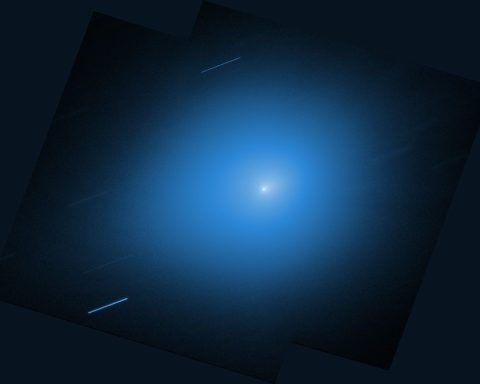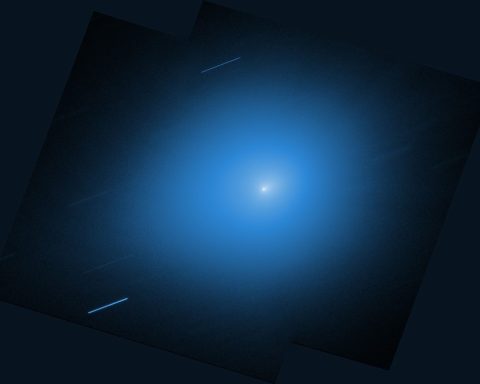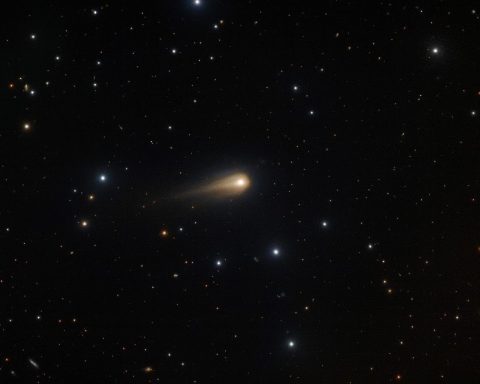Key Facts
- Mars biosignature hint: NASA’s Perseverance rover found a Martian mudstone with potential signs of ancient microbial life, as minerals in the rock resemble those formed by microbes on Earth [1] [2]. Acting NASA Administrator Sean Duffy said scientists “can’t find another explanation… this very well could be the clearest sign of life we’ve ever found on Mars” [3], though it’s not confirmed life.
- Hawking’s black hole theorem confirmed: Physicists analyzing gravitational waves from a January 2025 black hole merger verified Stephen Hawking’s 1971 prediction that the total event horizon area can never decrease [4]. Two black holes merged into one with a surface area growing from ~240,000 km² to ~400,000 km², exactly as Hawking’s area theorem predicts [5]. Columbia University astrophysicist Maximiliano Isi noted this shows ideas from the 1970s “manifested in actual data… happening almost exactly as predicted” [6].
- Unique cosmic explosion puzzles astronomers: Scientists observed an unprecedented gamma-ray burst (GRB) that lasted 100–1,000 times longer than typical GRBs and even repeated multiple times in one day [7] [8]. The intergalactic blast (dubbed GRB 250702B) defies known cosmic explosion models. “If this is a massive star, it is a collapse unlike anything we have ever witnessed before,” said lead author Andrew Levan of Radboud University [9].
- Diabetes breakthrough frees patients from insulin: A stem-cell derived cell therapy enabled 10 of 12 patients with type 1 diabetes to stop insulin injections for over a year [10] [11]. Lab-grown pancreatic islet cells (Vertex’s zimislecel therapy) let patients produce their own insulin. “This is a landmark study — this cannot be overstated,” said University of Miami researcher Giacomo Lanzoni (not involved in the trial) [12], suggesting a potential functional cure. Experts caution patients must take immunosuppressants to protect the new cells [13] as further trials continue.
- “Forever chemicals” pervade popular beers: A new analysis found 95% of U.S. beers tested contain PFAS, the toxic “forever chemicals” known to persist in the environment [14]. The highest levels were in beers brewed where local water supplies are contaminated [15] [16]. “As an occasional beer drinker myself, I wondered whether PFAS in water supplies was making its way into our pints,” said research lead Jennifer Hoponick Redmon, hoping the findings spur better water treatment [17].
- Climate research at risk: U.S. polar scientists sounded an alarm over plans to decommission the country’s only Antarctic research icebreaker, the Nathaniel B. Palmer. In a letter to NSF and Congress, 170 researchers warned terminating the ship’s lease will cripple studies of sea ice, ocean carbon uptake and melting glaciers [18] [19]. “Without a ship, the United States wouldn’t even be an important player in that research,” warned Lamont-Doherty oceanographer Robert F. Anderson [20], noting other nations are ramping up Antarctic missions.
- Human evolution timeline upended: Fossils discovered in Ethiopia show that early Homo coexisted with Australopithecus 2.6 million years ago, challenging the linear “march of progress” view of human evolution [21] [22]. “Humans are only one species that make up a twig of a bigger family tree – it’s quite bushy, and what we found is another twig that was previously unknown,” said University of Arkansas anthropologist Lucas Delezene [23]. The Nature study places some of the earliest Homo teeth alongside Australopithecus at the same site [24] [25], suggesting multiple hominin species shared the landscape in Africa.
Space & Astronomy
Possible life on Mars – “potential biosignatures”: NASA’s Perseverance rover has uncovered one of the most tantalizing clues yet that Mars may have hosted ancient life. Scientists reported that a sample of fine-grained, iron-rich mudstone rock from Jezero Crater contains minerals (including vivianite and greigite) that on Earth often form due to microbial activity [26]. The rover team spent a year analyzing data from the rock, nicknamed “Sapphire Canyon,” before announcing what they call a “potential biosignature” – a chemical or textural signal that could have a biological origin [27]. The rock, which dates back ~3.6 billion years to when Jezero held a lake, has unusual ring-shaped and speckled features resembling “leopard spots” and “poppy seeds” [28]. Those could have been produced by chemical reactions involving microbes as the sediment turned to stone. Sean Duffy, NASA’s acting administrator, hailed the find: after exhaustive checks, “we can’t find another explanation, so this very well could be the clearest sign of life that we’ve ever found on Mars – which is incredibly exciting” [29]. Officials were quick to caution that this is not proof of life, as non-biological processes might explain the signals [30] [31]. The rover has sealed the intriguing sample for a future mission to return to Earth, where labs could conclusively test for ancient microbial fossils. Still, the discovery stands as Perseverance’s most significant milestone yet, marking “one of the best pieces of evidence to date” that Earth’s arid neighbor once harbored life [32].
Record-breaking gamma-ray burst mystifies astronomers: In other space news, telescopes caught an astounding gamma-ray burst (GRB) that challenges our understanding of cosmic explosions. GRBs are normally one-time flashes lasting seconds or minutes, spawned by cataclysmic events like supernovae or neutron star mergers. But on July 2, a GRB designated GRB 250702B defied expectations – it flared multiple times over 10 hours [33] [34]. NASA’s Fermi satellite first detected three distinct bursts in a day, an apparent impossibility since the blast that produces a GRB (for example, a star’s collapse) should destroy the source and never repeat [35]. Moreover, this GRB’s duration – 100 to 1,000 times longer than typical – puts it in uncharted territory [36]. An international team led by Andrew Levan (Radboud University, Netherlands) scrambled for answers. Using ESO’s Very Large Telescope in Chile, they pinpointed the source well outside our galaxy, meaning the eruption was even more energetic than if it were local [37]. “Before these observations, the feeling was this GRB must have originated within our galaxy,” Levan said – the VLT overturned that assumption [38]. What could cause such a strange outburst? One hypothesis is an utterly abnormal supernova: “If this is a massive star, it is a collapse unlike anything we have ever witnessed before,” Levan noted in an ESO statement [39]. Another idea is a tidal disruption event – a star being shredded by a black hole – though the properties still don’t fully match [40]. Co-author Antonio Martin-Carrillo (University College Dublin) emphasized how baffling the repeats were: “Gamma-ray bursts never repeat… the object that produces the burst is destroyed”, so seeing one burst three times is essentially unheard of [41]. The team, who published their findings in Astrophysical Journal Letters, continue to monitor the aftermath with telescopes including Hubble and the James Webb Space Telescope, hoping for clues to this one-of-a-kind cosmic event [42].
Physics
Gravitational waves prove Hawking right: This week marks a triumph in fundamental physics – and a posthumous victory for Stephen Hawking’s most famous black hole theorem. In Physical Review Letters, researchers from the LIGO–Virgo–KAGRA collaboration reported the clearest test yet of Hawking’s 1971 area theorem, which posits that the total surface area of a black hole can never decrease [43] [44]. On Jan 14, 2025, LIGO’s upgraded detectors in the U.S. caught gravitational waves from two distant black holes (about 30–40 solar masses each) spiraling together [45]. Thanks to a decade of detector improvements, the signal was far crisper than the first-ever detection in 2015 [46] [47]. This allowed scientists to precisely measure the merged black hole’s size. The two initial black holes had a combined event-horizon area of roughly 240,000 km² (about the size of Oregon) before merging; afterwards, the single black hole’s area was about 400,000 km² (approaching California’s size) [48]. In other words, area increased, as Hawking’s theory demands. “Hawking’s theory says that the final area…has to be bigger than the sum of the two initial areas, and this is what we demonstrated observationally with that signal,” said Katerina Chatziioannou, a Caltech physicist on the LIGO team [49]. The result boosts confidence in the general relativity underpinning black hole physics, while also probing the quantum mysteries Hawking’s ideas entail. Maximiliano Isi (Columbia University and Flatiron Institute) noted the poetic moment – testing Hawking’s prediction was dreamed of when LIGO first succeeded in 2015. Now it’s reality: “All of these ideas that people thought up in the ’70s… now they are manifested in actual data. We see these things happening almost exactly as predicted” [50]. Hawking, who died in 2018, unfortunately did not live to see this confirmation, but the findings cement his legacy. The team achieved 99.999% confidence that the black hole area grew after merger [51] [52], essentially validating Hawking’s Black Hole Area Theorem as an observable law of nature.
(In brief: Physicists also floated an exotic proposal this week: the first-ever “neutrino laser.” A team at MIT described how a beam of ultra-cold, radioactive atoms could be induced to emit coherent neutrinos – a neutrino analog of laser light [53]. Such a device, while purely theoretical for now, could someday enable new experiments probing fundamental particles. )
Health & Medicine
Stem cell therapy conquers diabetes in trial: A groundbreaking cell therapy is offering new hope to people with type 1 diabetes. In a Phase I/II study reported in the New England Journal of Medicine, 12 patients received an infusion of lab-grown pancreatic islet cells – and after a single treatment, 10 of them no longer needed insulin injections a year later [54] [55]. The implanted cells effectively replaced the patients’ destroyed beta cells, producing insulin in response to blood sugar levels. Researchers at Vertex Pharmaceuticals bioengineered these islet clusters from stem cells, a scalable alternative to scarce donor pancreases [56]. The result, if borne out in larger trials, amounts to a functional cure for many with type 1 diabetes. Independent experts have lauded the outcome. “This is a landmark study – this cannot be overstated,” said Giacomo Lanzoni, a University of Miami diabetes researcher not involved in the trial [57]. He emphasized that it “opens the door to restoring insulin production” for patients worldwide [58] [59]. However, there are important caveats. Because the infused cells are allogeneic (not the patient’s own), recipients must take lifelong immunosuppressant drugs to prevent rejection [60]. “Immunosuppression is not a walk in the park,” Lanzoni noted, pointing to infection risks [61]. Two participants in the study died of causes deemed unrelated to the therapy (one from a surgical complication, one from a preexisting condition) [62]. Despite such risks, clinicians are optimistic. Tom Donner, director of the Johns Hopkins Diabetes Center, said “coming off insulin therapy is a remarkable achievement” that could greatly improve patients’ quality of life [63]. Vertex has expanded the trial to 50 people and aims to seek regulatory approval in 2026 [64]. If successful, this therapy – known as zimislecel (VX-880) – would be the first-ever treatment to liberate diabetics from insulin shots, a milestone after a century of insulin dependency.
Other medical headlines: Researchers at the University of Cambridge unveiled a “smart” artificial cartilage that could transform arthritis care. The gel-like material is infused with anti-inflammatory drugs and is designed to be implanted in arthritic joints [65]. Uniquely, it senses when inflammation is flaring – the surrounding tissue’s pH becomes slightly more acidic – and in response, the material softens and releases medication on the spot [66] [67]. “These materials can ‘sense’ when something is wrong in the body and respond by delivering treatment right where it’s needed,” explained Dr. Stephen O’Neill, first author of the study [68]. This targeted delivery could maximize pain relief in joints while minimizing side effects elsewhere [69]. Though still in lab tests, the approach could lead to implants for chronic conditions that automatically dispense drugs during disease flare-ups. And in an intersection of diet and antibiotics: A study from UC San Diego found that everyday compounds like caffeine can subtly weaken certain antibiotics. In experiments, E. coli bacteria exposed to caffeine and other common chemicals showed genetic changes that reduced their susceptibility to antibiotic drugs [70]. The finding (published Sep 11) raises the possibility that dietary habits or over-the-counter supplements might influence antibiotic effectiveness, though more research is needed to see if the effect occurs in patients.
Technology & Innovation
On-demand drug delivery in a “living” material: (See Artificial Cartilage in Health & Medicine above – a Cambridge-designed biomaterial that merges bioengineering and chemistry to treat disease in situ.) Beyond biotech, chemists at the University at Albany announced a next-gen rocket fuel compound that packs 150% more energy than conventional propellants [71]. The molecule, made of manganese and boron (manganese diboride), could significantly boost the payload and range of future spacecraft if it proves stable and safe to handle. In computing, no singular breakthrough grabbed headlines on these days, but the ongoing conversation around AI’s environmental footprint got a data-driven update: A report detailed the surprisingly large energy cost of AI models like ChatGPT, breaking down how cloud servers and GPUs devour electricity with each user prompt. Researchers are calling for more transparency and efficiency in AI deployments [72], as the industry grapples with sustainability.
(No major gadget releases or tech policy shifts were reported in this 48-hour window, but the scientific advances in materials and AI highlight the rapid innovation across tech domains.)
Environment & Climate
Scientists fight to save Antarctic research ship: In climate science circles, alarm bells rang on Sept 11 over a looming gap in Antarctic research capabilities. The U.S. National Science Foundation revealed plans to stop funding the RV Nathaniel B. Palmer – a 30-year-old icebreaker that is the nation’s only dedicated Antarctic research vessel [73] [74]. The Palmer has enabled countless discoveries in oceanography, marine biology, glaciology and climate over its storied career, from drilling into ancient ice shelves to studying the rapid melt of Thwaites Glacier [75] [76]. Its potential retirement in October sparked an outcry from the polar science community. A total of 170 scientists (including 10 Columbia University researchers) sent a letter to NSF and Congress urging a reversal of the decision, calling the ship “necessary” and irreplaceable for Antarctic science [77] [78]. “The only way to study sea ice is with a vessel… you can’t do it from land,” stressed Lamont-Doherty Earth Observatory geochemist Robert F. Anderson [79]. Satellite sensors and drones can’t fully substitute for a capable icebreaker that accesses remote ice-covered seas and samples ocean depths [80]. Anderson noted the Southern Ocean’s outsized importance as a carbon sink – it absorbs more CO₂ than it emits – and the Palmer’s key role in understanding that system [81]. Losing the ship, he warned, would surrender U.S. leadership in Antarctic science just as other nations (China, South Korea, the U.K., etc.) expand their polar programs [82]. The researchers urged not only keeping the Palmer afloat but also investing in a next-generation icebreaker to continue America’s legacy in the high south [83]. As of now, NSF’s 2026 budget request does include terminating the Palmer’s lease [84] – setting up a high-stakes battle between scientists and policymakers over funding the future of U.S. climate research at the bottom of the world.
PFAS contamination found in beer: A sobering environmental health finding came on Sept 12: toxic “forever chemicals” (PFAS) have leached into a vast majority of tested beers. Researchers with the American Chemical Society tested 23 popular beers from across the United States and found PFAS in 22 of them (95%) [85]. PFAS (per- and polyfluoroalkyl substances) are synthetic chemicals notorious for persisting indefinitely in the environment and accumulating in living organisms. They’re linked to health issues from hormonal disruption to cancer. The study, published in Environmental Science & Technology, showed that beers brewed in regions with known PFAS-polluted water supplies had the highest levels [86] [87]. For example, breweries near North Carolina’s Cape Fear River basin – contaminated by PFAS from industrial sources – produced beers with some of the greatest concentrations and variety of PFAS compounds [88] [89]. Even big-name beers from unspecified “large companies” showed contamination, indicating the problem isn’t limited to small locales [90]. Jennifer Hoponick Redmon, a researcher at RTI International who led the study, said the idea sprang from a personal hunch: “As an occasional beer drinker myself, I wondered whether PFAS in water supplies was making its way into our pints.” The answer was yes – clearly – which “shows that PFAS contamination at one source can spread into other products”, the authors wrote [91] [92]. The concentration of PFAS in the beers ranged up to 13 parts per trillion; regulators are only just setting drinking water limits (the EPA’s new limit for drinking water is 4 ppt for PFOA/PFOS). While the beer levels were generally low, the presence of any PFAS underscores how pervasive these pollutants have become. The researchers call for greater awareness among brewers and authorities, noting that standard brewery filtration systems aren’t designed to remove PFAS [93]. Upgrading water treatment at breweries or municipal plants may be needed to keep these “forever chemicals” out of our food and beverages [94]. For consumers, the study is another reminder that PFAS pollution is widespread – even reaching your pint glass – and it adds pressure on industries and regulators to curb PFAS at the source.
(Elsewhere in climate news: Scientists from the UK Met Office confirmed that Summer 2025 was the hottest ever recorded in Britain, an event so extreme it would’ve been a 1-in-340 year occurrence without climate change, but is now a 1-in-5 year event due to global warming [95] [96]. Japan and South Korea likewise saw record-breaking summer heat [97]. And at the first-ever Africa Climate Summit in Nairobi, African leaders jointly urged wealthy nations to increase funding for the continent’s green development, arguing that Africa is ready to leap toward clean growth “provided we are supported with finance, technology and capacity-building,” as Tanzania’s climate envoy Richard Muyungi told delegates [98] [99].)*
Biology & Evolution
Human origins story gets more complex: Two species of early humans, not one, roamed eastern Africa side by side 2.6 million years ago – that’s the implication of a spectacular fossil discovery announced on Sept 11. In the Afar region of Ethiopia, an international team found fossil teeth belonging to our own genus Homo in sediment dated to 2.6 Ma, and in those same deposits, teeth from an Australopithecus species [100] [101]. It appears that some of the earliest members of genus Homo (possibly Homo habilis or a close relative) co-existed with late-surviving Australopithecines in this region [102] [103]. Until now, researchers thought Australopithecus (exemplified by the famous “Lucy”) had vanished from Ethiopia by ~3.0 Ma, giving way to Homo as a lone successor [104] [105]. The new evidence “rewrites the first chapter of human evolution”, according to study co-author Lucas Delezene of University of Arkansas [106]. It turns out the evolutionary tree was not a straight line of one ancestor species replacing another; instead, it was a tangled bush with branches overlapping. “People often think evolution is a linear progression… but in reality humans are only one species that make up a twig of a bigger family tree – it’s quite bushy and what we found is another twig that was previously unknown,” Delezene explained [107]. The fossils, described in Nature, include several hominin teeth that fill a once-sparse time period in the record [108] [109]. By carefully comparing their shapes, the team identified some as early Homo and others as Australopithecus, all from ~2.6 million-year-old layers [110] [111]. This challenges the notion that the emergence of Homo immediately drove Australopithecus to extinction. Instead, at Ledi-Geraru (the site), these two distant cousins apparently shared the landscape – potentially even interacted – for some period of time [112] [113]. It raises new questions: Did they compete for food or occupy different niches? Did Homo’s dietary flexibility or tool use (though no stone tools this old were found here) help it eventually outlast Australopithecus [114] [115]? The discovery also solidifies the antiquity of Homo – pushing confirmed fossils of our genus to at least 2.8 Ma [116] – and underscores that human evolution was multibranched. As Delezene put it, the old “March of Progress” image is misleading; even the earliest chapters of human ancestry had several hominin species coexisting across Africa [117]. The team plans further excavations, hopeful that more fossils (perhaps even parts of skulls or skeletons) could reveal what these proto-humans looked like and how they lived [118]. It’s an exciting reminder that significant surprises still lie buried in the earth, waiting to reshape our origin story.
Wildlife and genetics notes: In a lighter discovery, entomologists reported that a common European insect, the Atlas blue butterfly, possesses an astonishing 229 pairs of chromosomes – the highest chromosome count of any animal on record [119] [120]. (For comparison, humans have 23 pairs). This chromosomal marvel may offer clues to butterfly evolution and genetics, though it poses a puzzle as to how such complexity arose. Meanwhile, biologists studying “zombie caterpillars” in Japan found that a species of Cordyceps fungus (the inspiration for The Last of Us) produces compounds that literally trick caterpillars into nonstop eating. The fungus infects a caterpillar and mind-controls its appetite so it gorges itself, benefiting the parasite – a striking real-world example of behavior control in nature [121] [122]. And paleontologists in Wales revealed a new species of Triassic-era dinosaur, Newtonsaurus cambrensis, identified from a large jaw fossil first unearthed over a century ago [123] [124]. Using 3D scans, scientists showed the 205-million-year-old creature was a 5–7 meter long carnivorous theropod – “unusually large for a Triassic theropod,” noted University of Bristol’s Dr. Owain Evans [125]. These diverse findings, from ancient human relatives to butterflies and dinosaurs, highlight the breadth of scientific exploration happening globally – even within just a two-day span.
Sources: The information in this report is drawn from reputable science news outlets and journals. Key sources include Reuters [126] [127], ScienceNews/Society for Science [128] [129], ScienceDaily [130] [131], Smithsonian Magazine [132] [133], NPR [134] [135], the Lamont-Doherty Earth Observatory at Columbia University [136] [137], and university press releases (University of Arkansas [138] [139], Cambridge [140] [141], etc.). Each development cited above was reported on September 11 or 12, 2025, via peer-reviewed studies, official announcements, or conference presentations, underscoring the truly global and cross-disciplinary nature of science news on these days.
References
1. www.reuters.com, 2. www.reuters.com, 3. www.reuters.com, 4. www.vpm.org, 5. www.vpm.org, 6. www.vpm.org, 7. www.smithsonianmag.com, 8. www.smithsonianmag.com, 9. www.smithsonianmag.com, 10. www.sciencenews.org, 11. www.sciencenews.org, 12. www.sciencenews.org, 13. www.sciencenews.org, 14. sciencedaily.com, 15. sciencedaily.com, 16. sciencedaily.com, 17. sciencedaily.com, 18. lamont.columbia.edu, 19. lamont.columbia.edu, 20. lamont.columbia.edu, 21. www.sciencedaily.com, 22. www.sciencedaily.com, 23. www.sciencedaily.com, 24. www.sciencedaily.com, 25. www.sciencedaily.com, 26. www.reuters.com, 27. www.reuters.com, 28. www.reuters.com, 29. www.reuters.com, 30. www.reuters.com, 31. www.reuters.com, 32. www.reuters.com, 33. www.smithsonianmag.com, 34. www.smithsonianmag.com, 35. www.smithsonianmag.com, 36. www.smithsonianmag.com, 37. www.smithsonianmag.com, 38. www.smithsonianmag.com, 39. www.smithsonianmag.com, 40. www.smithsonianmag.com, 41. www.smithsonianmag.com, 42. www.smithsonianmag.com, 43. www.vpm.org, 44. www.vpm.org, 45. www.vpm.org, 46. www.vpm.org, 47. www.vpm.org, 48. www.vpm.org, 49. www.vpm.org, 50. www.vpm.org, 51. sciencedaily.com, 52. sciencedaily.com, 53. scitechdaily.com, 54. www.sciencenews.org, 55. www.sciencenews.org, 56. www.sciencenews.org, 57. www.sciencenews.org, 58. www.sciencenews.org, 59. www.sciencenews.org, 60. www.sciencenews.org, 61. www.sciencenews.org, 62. www.sciencenews.org, 63. www.sciencenews.org, 64. www.sciencenews.org, 65. scitechdaily.com, 66. scitechdaily.com, 67. scitechdaily.com, 68. scitechdaily.com, 69. scitechdaily.com, 70. www.sciencedaily.com, 71. scitechdaily.com, 72. www.sciencenews.org, 73. lamont.columbia.edu, 74. lamont.columbia.edu, 75. lamont.columbia.edu, 76. lamont.columbia.edu, 77. lamont.columbia.edu, 78. lamont.columbia.edu, 79. lamont.columbia.edu, 80. lamont.columbia.edu, 81. lamont.columbia.edu, 82. lamont.columbia.edu, 83. lamont.columbia.edu, 84. lamont.columbia.edu, 85. sciencedaily.com, 86. sciencedaily.com, 87. sciencedaily.com, 88. sciencedaily.com, 89. sciencedaily.com, 90. sciencedaily.com, 91. sciencedaily.com, 92. sciencedaily.com, 93. sciencedaily.com, 94. sciencedaily.com, 95. www.weforum.org, 96. www.weforum.org, 97. www.weforum.org, 98. www.weforum.org, 99. www.weforum.org, 100. www.sciencedaily.com, 101. www.sciencedaily.com, 102. www.sciencedaily.com, 103. www.sciencedaily.com, 104. www.sciencedaily.com, 105. www.sciencedaily.com, 106. www.sciencedaily.com, 107. www.sciencedaily.com, 108. www.sciencedaily.com, 109. www.sciencedaily.com, 110. www.sciencedaily.com, 111. www.sciencedaily.com, 112. www.sciencedaily.com, 113. www.sciencedaily.com, 114. www.sciencedaily.com, 115. www.sciencedaily.com, 116. www.sciencedaily.com, 117. www.sciencedaily.com, 118. www.sciencedaily.com, 119. www.sci.news, 120. www.sci.news, 121. www.sciencenews.org, 122. www.sciencenews.org, 123. www.sci.news, 124. www.sci.news, 125. www.sci.news, 126. www.reuters.com, 127. www.reuters.com, 128. www.sciencenews.org, 129. www.sciencenews.org, 130. sciencedaily.com, 131. sciencedaily.com, 132. www.smithsonianmag.com, 133. www.smithsonianmag.com, 134. www.vpm.org, 135. www.vpm.org, 136. lamont.columbia.edu, 137. lamont.columbia.edu, 138. www.sciencedaily.com, 139. www.sciencedaily.com, 140. scitechdaily.com, 141. scitechdaily.com










